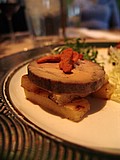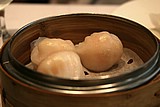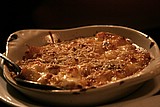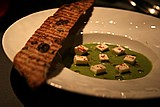Home |
Restaurants by City
|
Food Photography |
Archive | Philosophy |
![]()
Right now we are eating in Seattle, Washington.
|
Monday
2004
Permalink
|
Tabla, New York, NY, tasted on February 20, 2004 There is a "shininess" to the concept of fusion food, it's superficial, but attractive. The culture of food has borrowed from the broader pop culture in that trends are popular. They are seams that businesses and media look for to ride to more popularity. And the notion that combining two or more ethnic cuisines into one "fusion" of sorts could result in interesting combinations strikes many people as interesting and novel (myself included). The problem is that typically these combinations end there - at novelty. The reason a particular ethnic food is usually so interesting and attractive is because it's been honed over hundreds (and sometimes thousands) of years. It's been based on trial and error combining indigenous and regional ingredients into just the right combinations. When someone decides to take the "hits" of a pair of ethnic cuisines and combine them, it is usually done casually, with more attention paid to the surface of the dish, the unlikely ingredients, instead of to the overall flavor. This difficult legacy means that when a chef tries to do a riff on an ethnic food by expanding the framework, and even combining it with another sensibility, the bar is high. This is exactly what Floyd Cardoz tries to do at Tabla in Manhattan. There is the more casual (and apparently more traditional) Bread Bar, downstairs, but we were eager to see what Tabla had to offer. We were already in a good mood as the decor at Tabla was beautiful with bright textured colors and mosaics draped around the old office building/bank lobby. Things started off with Pink Lentil Soup - French Lentils, Leeks, and Ginger Yogurt. This spicy lentil; soup had the traditional Indian flavor base - a combination of savory spices each with distinct and pungent aromas and tastes. But there were also some interesting new flavors on top of the traditional ones. This was true from a textural perspective as well. The soup was followed up with a Lamb Confit Samosa - Black Chickpeas Hummus, and Cucumber Salad. The samosa was 100% light flakey spicy goodness. At this point I was intrigued. Lentil Soup? Samosa? Nothing non-traditional about those choices. But they each had a refined edge and some seemingly non-traditional ingredients. I'll admit I'm not nearly as deep in my knowledge of Indian food as I'd like to be, but I don't know how traditional the leeks, ginger yogurt, and chummus was in each of the dishes. Was it fusion? Maybe a fusion of Indian cuisine with modern French and American techniques and refinement. I was enjoying myself so far. Next up was a Basmati Risotto with Wild Mushrooms, Coconut, and Pea Shoots. The risotto was creamy and tangy with fresh herbs and coconut flavors, A bunch of enjoyable texture came from the shredded herbs. This dish was salty and good. And again it was a subtle twist on the traditional. Using the basmati rice, but preparing it as the risotto. I also know that some regions of India (especially in the south) definitely use coconut in their dishes making it seem like a cousin of Thai food sometimes (at least to my ignorant palate).There was also Warm Stuffed Locale with Apple, Roasted Vegetables, Roquefort, Toasted Walnuts, and Cider Vinaigrette. OK. I am not a huge salad fan as it often seems to me to be a random collection of ingredients that nobody felt like properly preparing. That said, the salads here were done with care and flavor and often served as the foundation to a main offering. The Organic Green Salad with Crisped Rice and Lime Chutney-Sherry Dressing was very good with its Indian flavor-tinged vinaigrette. I didn't quite enjoy the Hamachi Tartare and "Cru" with Sea Urchin, Lemon Confit, and Toasted Coriander. Something about it was not super, but the delicate savory spices and sour complements were nice. The next dish was also nothing to write home about - Salad of Pork Confit with French Lentils, Pickled Onions, and Cider Mustard Vinaigrette. The pork was just ok but it did fall apart on my fork. Luckily as the item on salad archetype started to get less interesting, the start of the next item on salad dish was superb. We at the Goan Crab Cake with Papadum, Goan Guacamole, and Tamarind Chutney. This was spicy on the finish. The papadum (a lentil crisp) was delicious, and the chutney was tangy and super complementary. Basically, the Crab rocked. We were at lunch with a native of Goa and she approved of this dish wholeheartedly. Less enjoyable was the Torchon of Hudson Valley Foie Gras with Grilled Pineapple, Cashews, and Peppercress. Even in a restaurant redefining the rules, this seemed a little out of place. The Foie Gras was not super flavorful though it was beautiful to look at. The condiments made it much better. The bread we got was mixed - the Nan was good, but the whole wheat paratha was dry and plain. Not to worry, next we were served Crisped Skate with Rock Shrimp Basmati Pilaf, Bacon, and Pea Shoots, with Sour Spicy Glaze. The skate and rock shrimp were the most interesting of the entrees. Beautifully cooked with a delicate spiced tomato goodness thrown in for good measure. The bacon overtones put this dish over the top. Unsurprisingly, while this dish had many ingredients, the result was accessible and simple. This is usually the way it is for the better dishes. Order out of confusion. Next up was the Salad of Duck Breast and Confit with Foie Gras, Roasted Beets, and Citrus Vinaigrette. I couldn't find the foie gras, but the temperature contrasts were good. And I'm always a fan of duck breast. Equally good was the Seared Hanger Steak and Sweet Spice Braised Oxtail -with "Bombay Rice Pilaf", with Peanuts and Leeks. Lots of flavor deeply integrated. Most fusion cooking that I've tried uses ethnic palettes as window dressing for their crappy food. But at Tabla the authentic Indian flavors were deeply ingrained in the food, and the main ingredients were still featured. And while the entrees were still too big for my taste (though I'm in the minority in this country), and the rest of the group I ate with were not quite as enthusiastic as I was, I found Tabla deeper than I expected, and a restaurant I'd like to eat at again. |
|||
Our Sponsors
Online Loans Conversion Strategies College Courses Surprise Birthdays Online Trading - Calendar and Event Schedules - Food Events and Calendars - Wine Events and Calendars - Digital Photography Resources - Jewish Gifts and Judaica - Howard Stern Podcast ponytailed blogger Jonathan Schwartz

Browse tastingmenu
Home |
Restaurants by City X |
Food Photography |
Archive | Philosophy |
![]()
Free eBooks: All About Apples
| Autumn Omakase
More:
Discussion |
Cool Food T-Shirts |
Ingredients
| Markets |
Recipes
Search |
Blog FAQ |
Other
Blogs
Best of tastingmenu
|
City View
Entry: July 6, 2006 |
Blue Plate
Entry: June 19, 2006 |
L'Atelier de Joël Robuchon
Entry: July 18, 2006 |
Browse by City
Boston | Chicago | Houston | Las Vegas | Los Angeles | Maui | New York | Philadelphia | Portland | San Francisco | Seattle | Toronto | Utah | Vancouver | Washington D.C.
Bangkok | Beijing | Hong Kong | Seoul | Tokyo
Amsterdam | Berlin | Italy | London | Madrid | Paris | Vienna
Browse by Month
2006
2005
2004
2003
2002
2001
Comments, questions, or feedback:
info / at / tastingmenu / dot / com
All pages Copyright (c) 2001-2006 tastingmenu.com
Last modified 11/27/06.




